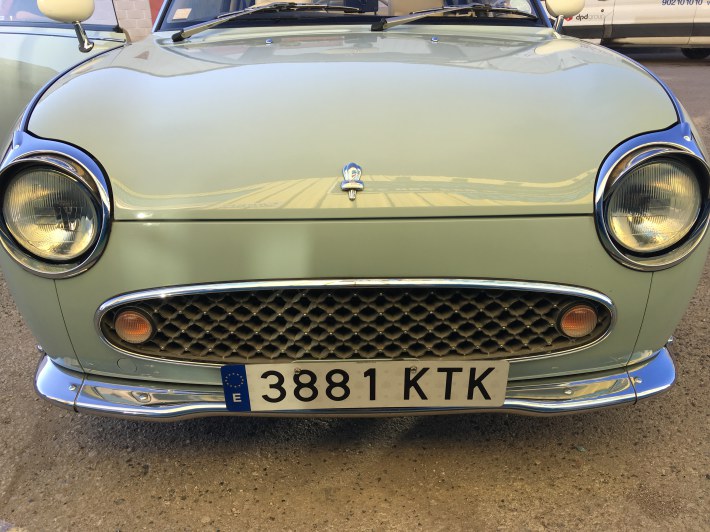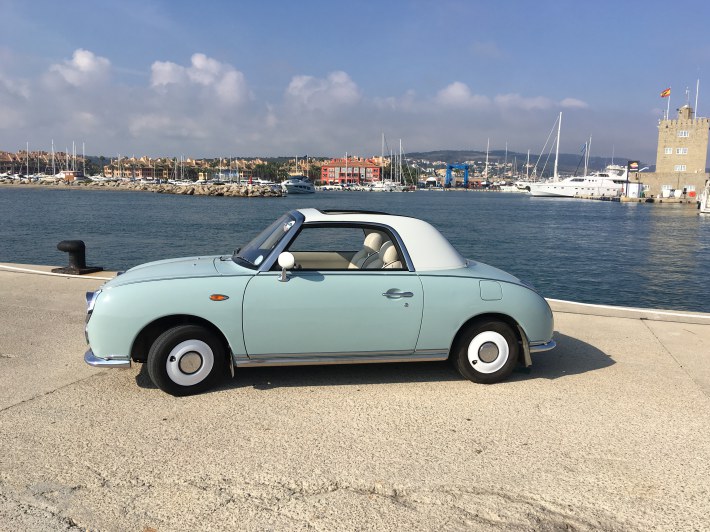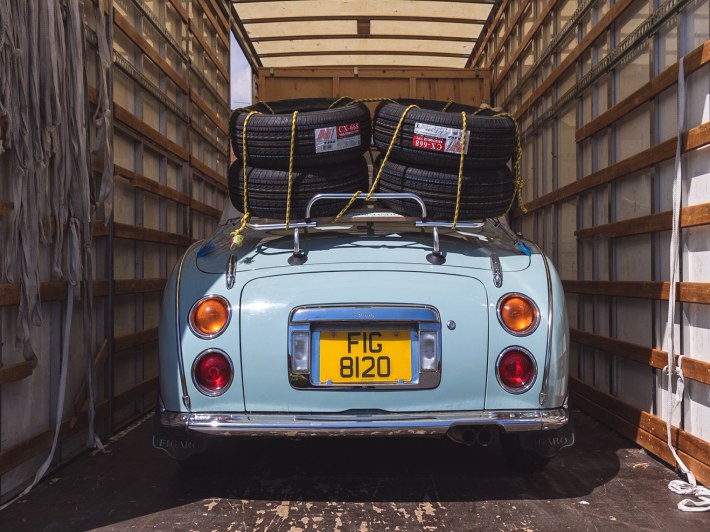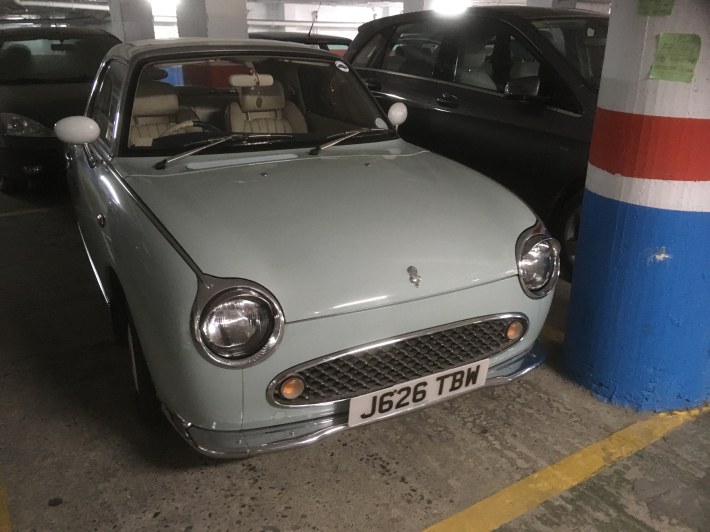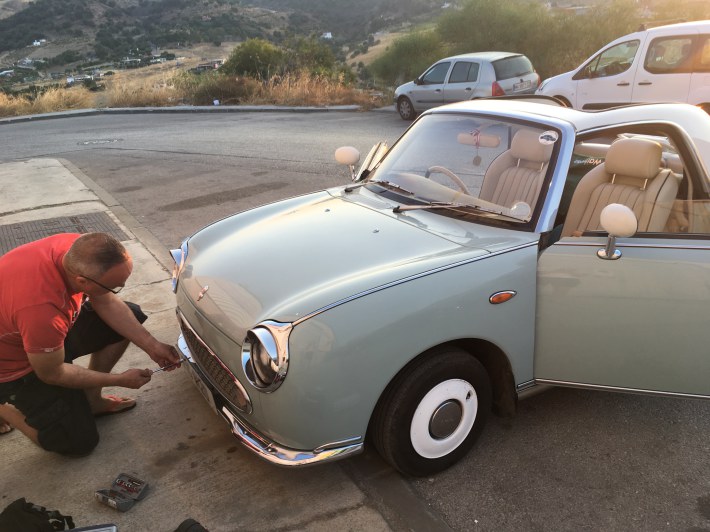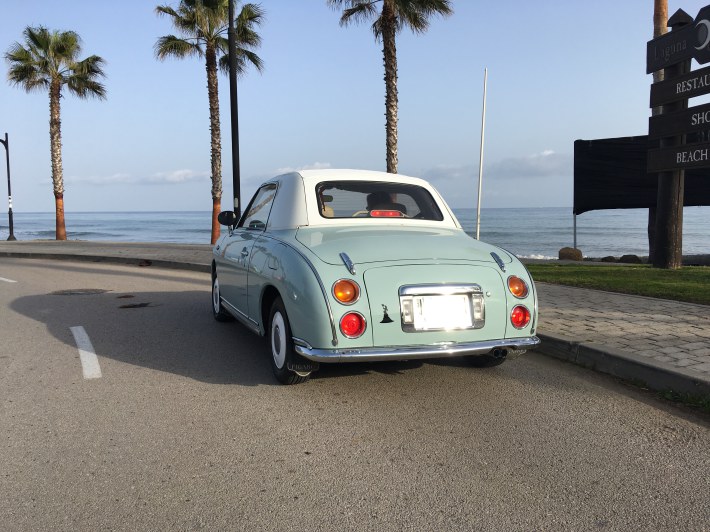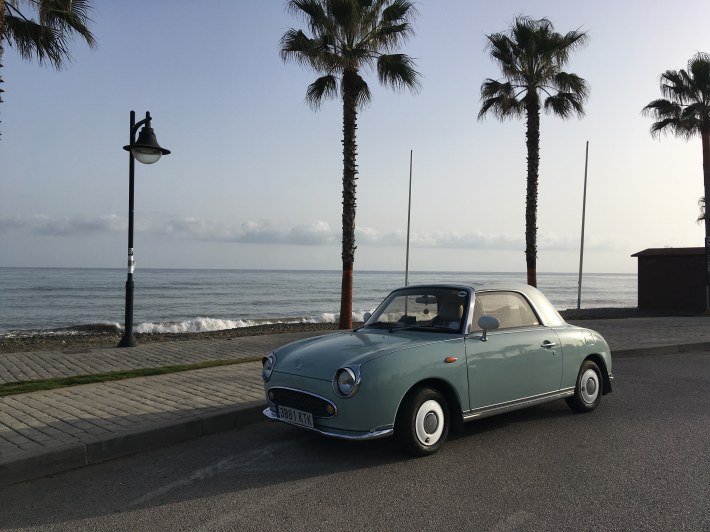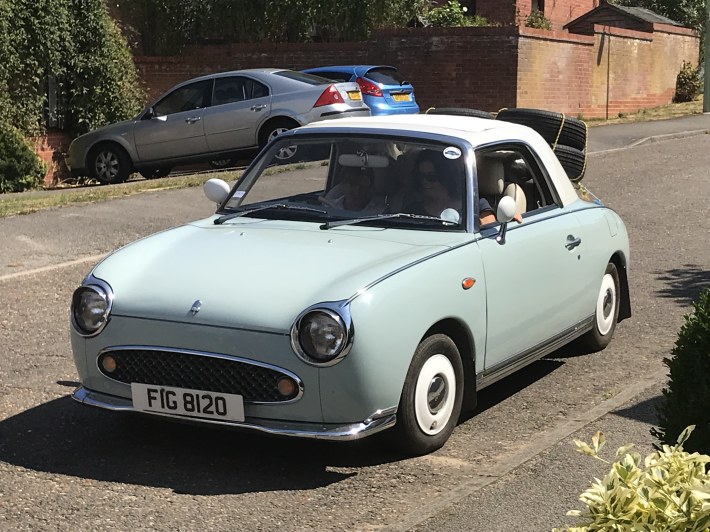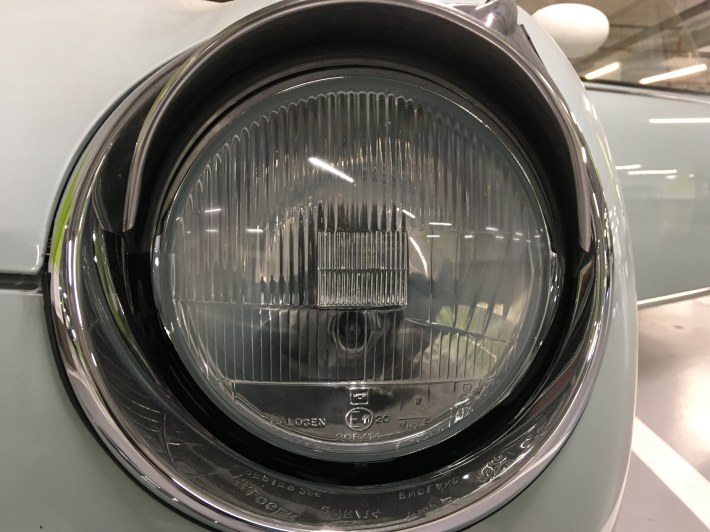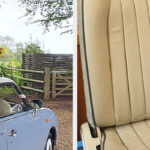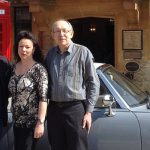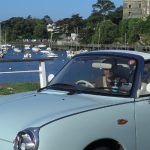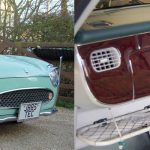Megan & John Bowles – Exporting a Figaro from UK to Spain
We’d pondered buying a property in Spain since 2015 after our youngest son moved with his girlfriend to Spain’s Costa del Sol. By chance a couple of years later while on holiday, we were offered a long-term rental apartment. Such opportunities are as rare as hens’ teeth, so we seized it.
Back home it dawned on us that we were renting a lovely apartment that would be used for just a few weeks a year. Shortly afterwards John resigned and within a couple of weeks our house was with Airbnb and we were crossing the Bay of Biscay en route to Bilbao. Our plan was to remain UK residents spending up to 6 months a year in Spain and renting out our UK home while we were away. However, by spring 2018 we had put our UK house up for sale intending to move lock, stock and Figaro to Spain.
We have driven to Spain and back several times in our Jeep Renegade. The thought of driving Doris though was a tad daunting. This was despite encountering a purple convertible Morris Minor on one journey up to Bilbao to catch the Portsmouth ferry. As we overtook it doing about 200 decibels we were concerned that if it was heading for the ferry then it might struggle to make it – let alone arrive in time. Imagine then a couple of hours later driving through Bilbao and seeing the same Morris Minor in your rear view mirror indicating to overtake! Shades of Steven Spielberg’s Duel.
So why not drive Doris down to the Costa del Sol? She would have over twice the horsepower of that Moggy. Well its a long way even at 120km/h (where legal) and cruising in a Figaro would be slower, take longer and require a couple of overnight stops. Add the cost of a ferry, cabin, tolls and petrol and it became expensive compared with using a transporter. Transporting a car to Spain can be done for under £800. Ultimately, we contracted with our removal company to take our furniture and Doris together. It cost more but Doris was cocooned inside the truck safe from the elements with four spare tyres strapped to the boot rack. Try buying those in Spain. The removal company also has a local depot so collecting her in Spain would be easy.
Our house sale progressed smoothly and we timed completion for just after the departure of our last Airbnb guests. Oh and we also managed to fit in a service, MOT and roof replacement. Doris’s journey to Spain took a couple of weeks and in the meantime, we were able to re-register her original UK registration retaining our cherished registration FIG8120 just in case. We collected her early one morning which necessitated a perfectly legal but dodgy looking plate swap outside the depot. She had arrived safe and sound and in good time to enjoy open top motoring in the sun.
Our rental apartment had its own underground parking space but with more good fortune we were able to rent a second space. Both cars would be safe underground and out of the sun.
It had taken just 6 months to sell our UK house but we managed to buy a Spanish apartment in 6 weeks! We were happy in our rental apartment and liked the area, but we were paying rent as well as for our furniture to be stored. Contrary to our expectations we quickly settled on an apartment a stone’s throw from our rental. We paid the 10% deposit within a week and completed a month later. After some renovations we moved across in November. It’s a lovely apartment and it ticks all the required boxes – except for a couple of garages. So we continue to rent the parking space for Doris.
There are many things to be aware of when buying in Spain. Should anyone want advice then feel free to contact us separately. There is a caveat though regarding any advice given; you can ask a question in Spain but the answer seems to depend on who, where and when you ask. Using a professional administrator called a Gestoria (pronounced Hes tor ree ah) is highly recommended.
We had obtained our foreigners ID or NIE numbers at the start of 2018. You need a NIE to open a bank account, buy a car, buy property and it even helps when buying a bus ticket online. We now needed to become residents, import the two cars and then exchange our driving licences. The Brexit timetable added a slight pressure as with a UK/EU licence an exchange should be straightforward with no requirement to take a Spanish driving test. As with most nationalities the Spanish have their own way of driving and norms; particularly associated with roundabouts and slip roads. Suffice to say it’s a good idea to always expect the unexpected.
Residency was straightforward with professional help. We had to prove that we would not be a burden on the Spanish state. This was achieved by demonstrating an adequate income and health insurance. Bank statements, a letter from a pension administrator and a health insurance policy with the appropriate cover sufficed. Our health insurance covers us when we’re back in the UK which is good news as our GP Surgery informed us that we should re-register after being out of the country for over 3 months; even for a holiday!
So next the cars; oh boy! This was to be much more difficult. The Jeep was manufactured in Italy and possessed all required EU homogulation certificates. All we needed was to buy and fit new headlamps and also a set of reversing and rear fog lamps. Unfortunately these were singles, not twins nor symmetrical and hence had to be replaced. It seems that the Jeep is assembled around its headlamps so changing was expensive. We were assisted by a local mechanic Phil who while still audibly Liverpudlian has been out here for years.
Doris as we all know is a grey import into the UK from Japan. We soon discovered that without EU homogulation the response from El Trafico in Malaga was a firm no. We sought advice from a classic car specialist who thought we could import her on an H or historic plate. He also put us in contact with an automotive gestoria. Unfortunately, in May 2018 the whole of the EU decided that a car had to be 30 years old to be considered historic and not merely 25. So unless we garaged her for 3 years then that route was barred too. Somewhat distraught we were told of a back door route around all of this homogulation malarkey.
As we were UK residents moving to become residents of Spain we could bring all our goods and chattels with us; including our cars! As a bonus we should also avoid import tax on the cars. Officially it is not an import tax merely a charge when you happen to put a car onto Spanish registration plates ie import it into Spain. The fee is based on a percentage of what the Spanish authorities think its worth. You look up the vehicle, year, model etc in a table and prepare to cough up. For a Figaro it would be calculated on the closest vehicle in the database ie a 1000cc 27-year-old Nissan Micra.
But now the tricky part. In order to benefit from this loop hole, we needed to prove we had left the UK. Fair enough perhaps but our tickets, removal company invoice and UK house sale documents counted for nothing. What we needed was a letter from our old town hall or the Embassy in Madrid. Perhaps the consulate in Malaga could help?
Now it turns out that what is wanted is not an actual letter but a form called a Bajar Consular. You are supposed to turn up at your consulate or embassy, swear an oath that you have left the UK to move to Spain and you get the required form – for a fee. Simples? Malaga is just an hour away. Ah but then you find out that the UK stopped issuing Bajar Consulars 5 years ago. A helpful English speaking soul at the consulate points you to a web page where all this is explained. All you have to do is print the explanatory page and hand it over to the Spanish authorities.
No; they want a Bajar Consular! The fact that you can’t get one is irrelevant. But a letter from our old town hall might still work. Yeah right, somewhere between no chance and fat chance.
First we managed to obtain an official email confirming that we were no longer liable for Council Tax. No, a Bajar Consular was required.
By chance we had received a letter from our old council’s Returning Officer stating that we were no longer on the electoral role. Obviously you need to be resident to be on the electoral role. Partial result! This was accepted as proof that we were not UK residents but there was no proof that we had ever been residents! It seems that we needed to prove that we hadn’t been resident in Spain and had merely nipped back to the UK for a couple of months just to buy a Figaro.
At this point around Christmas we thought we would be taking Doris back to the UK to be sold. In the meantime, she had been with Phil the Mechanic having her lights changed. We already had a red LED fog lamp in one of the reversing lamp housings. This was simply changed over from right to left but of course the headlamps were a lot more tricky. We had been advised that Mk1 VW Golf or Nissan Prairie/Patrol lamps would fit albeit they would be small at 7 inches diameter compared with the original 8 inches. We bought a pair of Golf’s and handed them over to Phil. By now he had become a Figaro fan spending hours researching online. The ones we had were difficult to fit securely and adjust. Plus, there was the gap between lamp and body. He was not happy! His answer was to nip along to his mate who is an original mini specialist and borrow a set of 7 inch mini ones complete with chrome collar. Much better. Although they are only 7 inches, the chrome collar takes up some of the space and the reflective surface masks the remaining gap. Phil and we are very happy with the look.
While waiting for new headlamp surrounds from the UK, a local car collector had shown an interest in Doris. He declared to Phil that he wanted her! We told Phil we could probably help him get one to add to his other 120 cars but Doris was not for sale. The response was he wanted Doris. He didn’t care what registration plates she had. So maybe this was to be her fate?
So we had a car with LHD lamps but which we couldn’t import into Spain. Yes there are plenty of other EU LHD countries that allow Figaro’s and of course there are one or two others in Spain. One is just up the road in Malaga which is the capital of our province. But remember you can ask a question in Spain but the answer seems to depend on who, where and when you ask.
Before we left the UK we’d had cause to meet with a local councillor and we had his contact details. We emailed him and asked for help. To his credit the next day we received an email from the electoral office confirming that we had been on the electoral role from 1999 when records began through to October 2018. El Trafico said yes! Deep sadness became deep joy. Wahoo and similar words were shouted.
However, we were still not home and dry. When you import a car it is subject to a technical inspection. For example, our Jeep had a tuning chip and side steps/running boards. Both modifications were legal in the UK, passed an MOT and have been accepted by UK and Spanish based insurers. However, these had to be removed as they were not original. As requested we supplied photographs of Doris from all angles including of the chassis numbers etc and where the chassis numbers were located. Technical data is available on the club website along with a PDF of an official letter from Nissan confirming the specifications. However, our inspector wanted to know where this information was displayed on the car. A sticker is now inside the passenger door frame.
One last piece of drama kept us awake for a couple of nights. We’ve not seen it written anywhere but apparently there is a time limit on importing cars in this manner. We still don’t know when this is triggered nor whether it is working or calendar days but we were fine. If such a limit exists then it may apply to the ‘import’ tax as while our proof of residency was acceptable for the purposes of importing the cars and specifically Doris; it was not accepted as proof to avoid paying the ‘import’ tax. Some you win some you lose. We were just happy we could keep and import Doris.
Just one more hurdle. Doris needed to pass the MOT or ITV as it is called in Spain. Testing is carried out by the local authority to be independent. We were given an appointment and we duly turned up. The testing station looks a bit like the entrance to a ferry terminal. You book in and await your turn looking up at a screen waiting for your registration to be displayed alongside a number of the lane you are to drive through. We were met by a young tester who fortunately spoke a little English, we can speak enough Spanish to get by but are not fluent in technical terms.
First up the emission test. Possibly as a result of certain dodgy Teutonic systems, the tester first warms up the engine then thrashes her at various revs so as to get a good representative whiff. Nothing was said but there were lots of green lights – phew.
Next seat belts, lights and wipers. Apparently, our main beams were a little high and we feared a fail but on we went to play a video game with the brakes using a rolling road. You apply gentle pressure until the needle gets into the yellow range and then you apply maximum pressure. Doris passed. The superiority of discs over drums was readily apparent.
The underside inspection first required a lesson in using a two-way radio and how to waggle the steering wheel when requested. Once trained, the tester left us to disappear under the car while we waited an instruction to waggle away.
After 30 minutes or so the test is over and you can drive out and park up.
You then queue up awaiting the result. Our registration was displayed and off we went for a chat. Smiles, relief, all good, no observations and an ITV sticker to apply to the windscreen.
A few days later we received the official documents ie the V5C and MOT certificate equivalents with her new number. Off we went to have her new plates fitted. The standard long plates would fit but cover the reversing/rear fog lamp and look naff. Fortunately, the workshop was right next to the ITV station. With their agreement we fitted a rear motorcycle plate. Not exactly pretty but we have since filled in the gaps with chrome self-adhesive card to improve how it looks.
And there we have her, a fully legal Nissan Figaro on Spanish plates. But there was one last expense. We had to cancel our existing insurance arranged over here and start again. Same agent, same insurer, same policy, same drivers, same car but with Spanish plates. Another couple of hundred euros lost in cancellation and administrative fees but hey its only money.
Totals costs ignoring insurance and running around
- Transport to Spain £1200
- Gestoria fees including taxes 730€
- ITV 150€
- Lamps and fitting 750€ (including the redundant Golf ones)
Was she worth it? Of course, and even more so given the ludicrous value of second hand cars in Spain and how rare she is over here.
